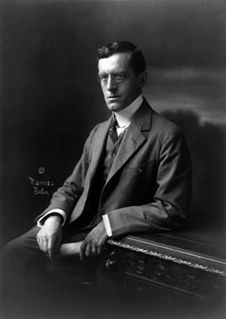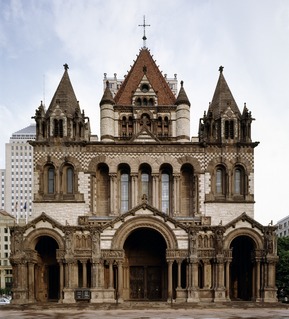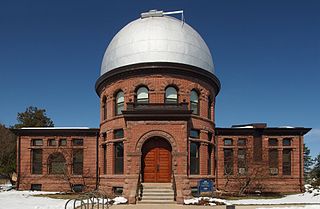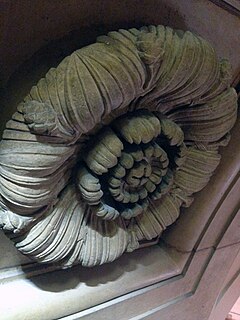
Carleton College is a private liberal arts college in Northfield, Minnesota. Founded in 1866, it had 2,105 undergraduate students and 269 faculty members in fall 2016. The 200-acre main campus is between Northfield and the 800-acre Cowling Arboretum, which became part of the campus in the 1920s.

Ralph Adams Cram was a prolific and influential American architect of collegiate and ecclesiastical buildings, often in the Gothic Revival style. Cram & Ferguson and Cram, Goodhue & Ferguson are partnerships in which he worked. Together with the architect Richard Upjohn and artist John LaFarge, he is honored on December 16 as a feast day in the Episcopal Church of the United States. Cram was a fellow of the American Institute of Architects.

St. Olaf College is a private liberal arts college in Northfield, Minnesota. The school was founded in 1874 by a group of Norwegian-American pastors and farmers led by Pastor Bernt Julius Muus. The college is named after the King and the Patron Saint Olaf II of Norway and is affiliated with the Evangelical Lutheran Church in America. The college was visited by King Olav in 1987 and King Harald V and Queen Sonja of Norway in 2011.

Richardsonian Romanesque is a style of Romanesque Revival architecture named after the architect Henry Hobson Richardson (1838–1886). The revival style incorporates 11th and 12th century southern French, Spanish, and Italian Romanesque characteristics. Richardson first used elements of the style in his Richardson Olmsted Complex in Buffalo, New York, designed in 1870. Multiple architects followed in this style in the late 1800s; Richardsonian Romanesque later influenced modern styles of architecture as well.

Bertram Grosvenor Goodhue was an American architect celebrated for his work in Gothic Revival and Spanish Colonial Revival design. He also designed notable typefaces, including Cheltenham and Merrymount for the Merrymount Press. Later in life, Goodhue freed his architectural style with works like El Fureidis in Montecito, one of the three estates designed by Goodhue.

Collegiate Gothic is an architectural style subgenre of Gothic Revival architecture, popular in the late-19th and early-20th centuries for college and high school buildings in the United States and Canada, and to a certain extent Europe. A form of historicist architecture, it took its inspiration from English Tudor and Gothic buildings. It has returned in the 21st century in the form of prominent new buildings at schools and universities including Princeton and Yale.
This is a timeline of historical events relating to Northfield, Minnesota.

Sir Herbert Baker was an English architect remembered as the dominant force in South African architecture for two decades, and a major designer of some of New Delhi's most notable government structures. He was born and died at Owletts in Cobham, Kent.

William Penn University is a private university in Oskaloosa, Iowa. It was founded by members of the Religious Society of Friends (Quakers) in 1873 as Penn College. In 1933, the name was changed to William Penn College, and finally to William Penn University in 2000.

Goodsell Observatory is an observatory at Carleton College in Northfield, Minnesota, United States. It was constructed in 1887 and was, at the time, the largest observatory in the state of Minnesota. The Goodsell Observatory and its predecessor, a smaller observatory that opened in 1878, served as a widely consulted timekeeping station, bringing national prominence to Carleton College in the late 19th and early 20th centuries.

Kasota limestone or simply, Kasota stone, also called Mankato stone, is a dolomitic limestone found in southern Minnesota, especially near the Minnesota River and its tributaries. This sedimentary rock is part of the Oneota Dolomite of southern Minnesota and is approximately 450 million years old. This particular limestone is rich in dolomite and magnesium, making it resistant to weathering, and it is thus widely used as a building material. Its name is taken from Kasota Township where the stone has been quarried.

The University of Minnesota Old Campus Historic District is a historic district located in Minneapolis, Minnesota. Listed in the National Register of Historic Places since 1984, it includes a number of historic buildings that were constructed during the late 1800s and early 1900s. The district represents the oldest extant section of the University of Minnesota campus.

Willis Hall is a historic building on the campus of Carleton College in Northfield, Minnesota, United States. It is listed on the National Register of Historic Places.

Scoville Memorial Library is a historic building on the campus of Carleton College in Northfield, Minnesota, United States. It is listed on the National Register of Historic Places. It was the college's library until the current library was built in the 1950s. Until 2016 it housed several student support organizations and the Cinema and Media Studies department. Currently the building is under intensive renovations and will soon house the Admissions and Financial Aid offices.
This is an incomplete list of historic properties and districts at United States colleges and universities that are listed on the National Register of Historic Places (NRHP). This includes National Historic Landmarks (NHLs) and other National Register of Historic Places listings. It includes listings at current and former educational institutions.

Knowles Memorial Chapel, built between 1931 and 1932, is an historic Mediterranean Revival building located on the campus of Rollins College in Winter Park, Florida, in the United States. On December 8, 1997, it was added to the National Register of Historic Places. On April 18, 2012, the AIA's Florida Chapter placed the Knowles Chapel at Rollins College on its list of Florida Architecture: 100 Years. 100 Places.

Normand Smith Patton was an American architect based in Chicago, Illinois and Washington, D.C.

The Drake University Campus Historic District is located in Des Moines, Iowa, United States. The historic district contains six buildings. Five of the buildings are collegiate buildings on the Drake University campus and one is a church. The period of significance is from when the university was founded in 1881 to the end of the presidency of Hill M. Bell in 1918. The historic district has been listed on the National Register of Historic Places since 1988. It is part of the Drake University and Related Properties in Des Moines, Iowa, 1881—1918 MPS.
Patton & Fisher was an architectural firm in Chicago, Illinois. It operated under that name from 1885 to 1899 and later operated under the names Patton, Fisher & Miller (1899–1901) and Patton & Miller (1901–1915). Several of its works are listed on the National Register of Historic Places.

The Sophia Astley Kirkpatrick Memorial Chapel, known as Kirkpatrick Chapel, is the chapel to Rutgers, The State University of New Jersey and located on the university's main campus in New Brunswick, New Jersey in the United States. Kirkpatrick Chapel is among the university's oldest extant buildings, and one of six buildings located on a historic section of the university's College Avenue Campus in New Brunswick known as the Queens Campus. Built in 1872 when Rutgers was a small, private liberal arts college, the chapel was designed by architect Henry Janeway Hardenbergh at the beginning of his career. Hardenbergh, a native of New Brunswick, was the great-great-grandson of Rutgers' first president, the Rev. Jacob Rutsen Hardenbergh. It was the third of three projects that Hardenbergh designed for the college.



















